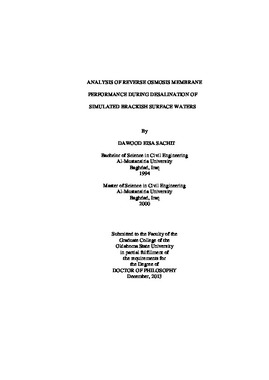| dc.contributor.advisor | Veenstra, John N. | |
| dc.contributor.author | Sachit, Dawood Eisa | |
| dc.date.accessioned | 2015-06-17T20:07:49Z | |
| dc.date.available | 2015-06-17T20:07:49Z | |
| dc.date.issued | 2013-12 | |
| dc.identifier.uri | https://hdl.handle.net/11244/15100 | |
| dc.description.abstract | In this study, three different brackish surface water qualities, which represented the water quality in the Iraqi marshes, were simulated and used as feed waters to run a flat sheet reverse osmosis (RO) membrane system. The performance of three different types of the RO membrane (Thin-Film Composite (SE), Cellulose Acetate (CE), and Polyamide (AD)), under these water qualities, was investigated. The effect of the high and low feed water temperature (37 degrees C and 11 degrees C) on the operation efficiency of the three RO membranes was also investigated. In addition, using the Microfiltration (MF) membrane to pretreat the feed water and its effect on the performance of the RO membrane was examined. The results revealed that the SE membrane produced the highest permeate flux, while the AD membrane produced the lowest permeate flux in all three feed waters. Also, the elemental analyses showed that the CE membrane had the least rejection percentage (from 91.1% to 99.2%), but the AD membrane had the highest rejection percentage (from 97.6% to 99.5%) for all the existing feed water ions. Moreover, using the MF membrane increased the permeate flux, particularly of the runs conducted with a high temperature, and slightly improved salt ions rejection ratios by the RO membranes. Additionally, all membranes at the temperature of 37 degrees C exhibited higher permeate fluxes than those of corresponding membranes at a lower temperature (11 degrees C). Furthermore, the main foulants from the simulated feed waters were diagnosed by using Scanning Electron Microscope (SEM) images and Energy-Dispersive X-ray Spectroscopy (EDXS) spectra. Finally, Fourier Transform Infrared Spectroscopy (FTIR) analysis was used to identify the functional groups of the organic matter deposited on the RO membrane surfaces. The SEM images and EDSX spectra suggested that the fouled material was mainly organic matter, and the major crystal deposited on the RO membrane was calcium carbonate (CaCO3). The FTIR spectra of the fouled RO membranes suggested that the constituents of the fouled material included aliphatic and aromatic compounds. | |
| dc.format | application/pdf | |
| dc.language | en_US | |
| dc.rights | Copyright is held by the author who has granted the Oklahoma State University Library the non-exclusive right to share this material in its institutional repository. Contact Digital Library Services at lib-dls@okstate.edu or 405-744-9161 for the permission policy on the use, reproduction or distribution of this material. | |
| dc.title | Analysis of reverse osmosis membrane performance during desalination of simulated brackish surface waters | |
| dc.contributor.committeeMember | Wilber, Gregory G. | |
| dc.contributor.committeeMember | Sanders, Dee Ann | |
| dc.contributor.committeeMember | Johannes, A. J. | |
| osu.filename | Sachit_okstate_0664D_13015.pdf | |
| osu.accesstype | Open Access | |
| dc.type.genre | Dissertation | |
| dc.type.material | Text | |
| dc.subject.keywords | brackish water | |
| dc.subject.keywords | permeate | |
| dc.subject.keywords | pretreatment | |
| dc.subject.keywords | reverse osmosis | |
| dc.subject.keywords | salt ion rejection | |
| thesis.degree.discipline | Civil and Environmental Engineering | |
| thesis.degree.grantor | Oklahoma State University | |
